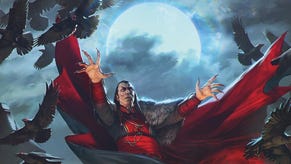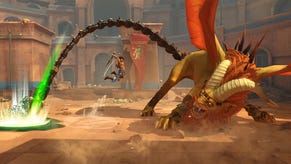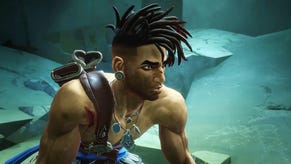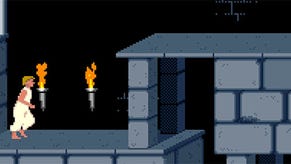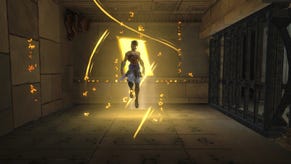Prince of Persia: The Lost Crown review - fabulous exploration and combat
Door dash.
There's something about a magic door. Who could resist them? I can't. I don't know anyone who can.
Prince of Persia: The Lost Crown is a lot of things. It's the latest game in a beloved series whose lineage stretches all the way back to the glory days of home computing. It's a metroidvania so beautifully put together it almost feels like a Plantonic example of the form. It's a promising sign that Ubisoft is starting to let a series' soul dictate the ultimate structure of a game, rather than pouring its molten life into the same open-world mould. And it's a game that really knows the value and impact of a magic door.
To wit: I'm in a kind of hub area, done up like a breezy Persian marketplace. There are people nearby I can talk to for various kinds of upgrades and trinkets, for a bit of training on the nuances of combat, and even for a bit of story background. But there's also this wall, and when I walk past the wall, a shape emerges, warmly picked out in gold. It looks like a door, but it's a door that would take me deeper into the world, into its third dimension, and this game is largely a 2D side-scrolling affair. Is it a door? Is it just a quirk of the lighting? What's going on here?
The Lost Crown is filled with moments like this. Like I said: venerable series, and a venerable genre, but prepare yourself for lovely instances of invention, of craft, moments that can genuinely make your heart skip a beat.
I have long since lost track of the threads of the Prince of Persia games, but this latest feels like a bit of a reimagining. You play as Sargon, a member of a crew of immortals who are on a quest to rescue a prince who's been spirited away to a cursed mountain. Things quickly go wrong, as they tend to when cursed mountains enter the frame. Time and space start to malfunction, monsters prowl and flap through the air on nasty wings, and boom, we're in metroidvania territory.
Suddenly, then, we're exploring a platforming world that stretches in all directions, with doors and passageways that require specific skills to be acquired before they can be opened. This is a game that threads combat and traversal through a complex space, asking players to commit to the architectural confusion, and to the need to remember promising threads that cannot currently be taken up but might prove interesting a few hours from now.
On that last point, The Lost Crown has a neat idea here. At any moment in the game you can take a snapshot of your surroundings and stick it to the map, to serve as a visual reminder of a place you want to return to later. Funny ledge you can't reach? Strange glowing block that doesn't seem to make any sense? Snap! I'll be back when I know more. It's an attempt to cut down on the memory tax of these most memory-taxing of games. It's also just a neat thing to do with the map, a kind of Polaroid approach to the world of ancient myth. I really like it.
In terms of combat and traversal and complex space, the game's doing pretty well too. Let's take these things in order.
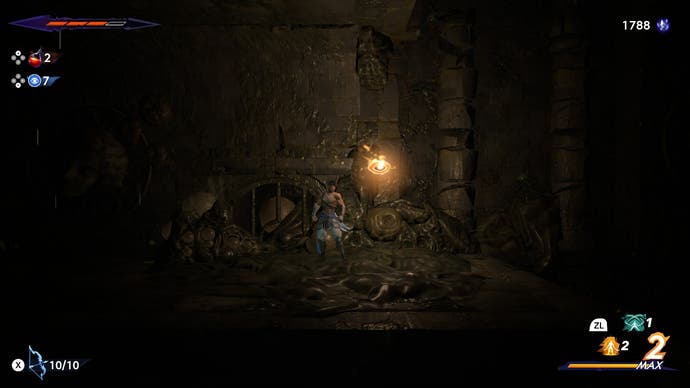
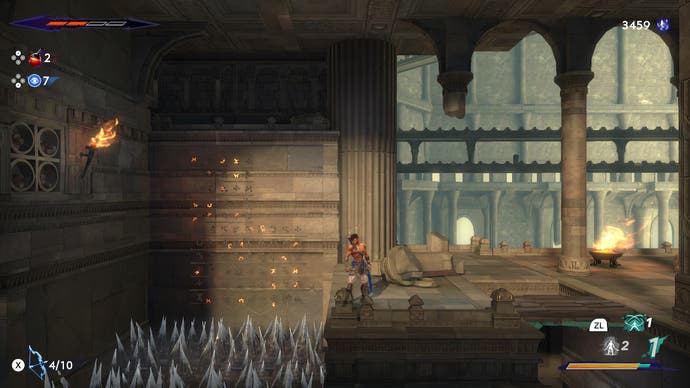
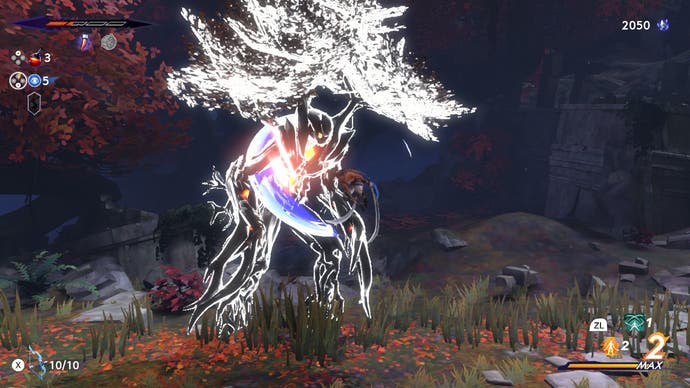
Combat here is fast and stylish, with Sargon's dual blades and swiping combos quickly joined by a bow with a decent auto target. Hacking away is a lot of fun, particularly given an approach to animation that lingers, lovingly, on hero poses, but the real heart of the fun comes with mastering the parry and dash systems, learning which tells - a gold flash - mean you can counter an attack and lay on extra damage and which tells - a red flash - mean that all you can do is get out of the way. With multiple enemies, or even some of the bosses, control of the space is crucial, so the air dash, once you have it, and the ground-slide are brilliant for closing gaps, opening gaps, and even sliding under foes to attack from behind - something the game is all too happy to anticipate in one particularly painful moment.
Alongside this, any attacks you land build a specials metre that allows you to unleash a killer move when it's full. These stack, so you can have several specials in play for reaching certain levels on the metre, and you earn more of the moves that you can swap in and out as things proceed. For sheer flourish, I became quite fond of an elaborate overhead attack that did massive damage to anything above me, but my standard, that I relied on pretty criminally during some encounters, was an ability that put down a healing area on the map that I then tried to stay within as I booted various baddies around. Lovely stuff.
Combat gives the game a lovely crunchy sense of progress, and it slots together quite neatly with traversal through various wriggly, oxbowing landscapes - an element of the game that feels just as intense and gymnastic. To put it another way, Sargon can walk, but that's hardly the point here. Amongst other things this is probably the wall-jumpiest game ever made, with many spaces terminating in wells or chimneys that invite you to bounce your way on to whatever's next. Throw in an air dash - autocorrect tried to give me air dachshund, there, which is a promising game pitch in its own right - and levels that encourage you to look up and down as much as left and right and you have an adventure where getting around always feels like a bit of a puzzle.
Brilliantly, the Lost Crown is eager to chain moves together to get you through some incredibly satisfying platforming gauntlets. Swinging blades and spike pits recall the first Prince of Persia beautifully, but then come crystal caverns where touching any surface at all means death, sand-pipes you can ride up and down, pirate caverns where you have to avoid triggering any traps - or where you might work out how to turn them against any nearby foes - and all manner of sewers and caverns. The game's beautiful, with rich colours, sharp edges and a real skill at giving you some evocative vistas to look at in the background, but it also threads itself together with a sustained joy. Someone loved making this map, I think, creating devious passageways and then coating them with magical forests one moment and castle crypts the next. I loved being here.

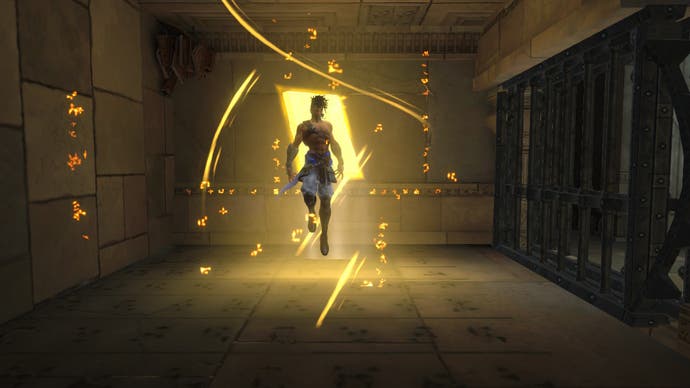
Adding to traversal - and providing that classic metroidvania gear-gating - are unlockable skills that tend to be fairly standard ideas for the genre but delivered with flair. To pick a few without spoiling them all, a double-jump is always welcome, particularly when a game holds it back as long as this one does. I also loved the slashing move that allowed me to grab items from the world and then hold them in a kind of Tetris holding slot, before flinging them back into the world. Wall that needs to be exploded? Grab and hold an explodey flower for the right moment. Too many enemies? Tetris Hold a few, and then, when you launch them back into the world, they'll fight alongside you for a bit. All of this stuff allows you to reach new parts of the map and think about old parts of the man in different ways. And it's always fun to just mess around with.
It's a really lovely metroidvania, in other words, and when you fling on some interesting uses of the series' existing time mechanics, you get something that truly feels like a Prince of Persia game. Don't expect the rewind abilities from the Sands of Time to define the adventure, but the cursed mountain you're exploring is a place where time has thoroughly lost its own thread: you're constantly running into people who remember events that you haven't witnessed yet, or are claiming to have spent far longer lost in this space than seems entirely plausible. Some of the most interesting stuff here is left for side quests, too. Side quests in a metroidvania! Hold me.
To quote my good friend the Air Daschund: what a rush. Prince of Persia: The Lost Crown is a real delight, a game that revels in both its genre and its own heritage, delivering some wonderful combat and exploration. All that and the odd secret door. Sold.
A copy of Prince of Persia: The Lost Crown was provided for review by Ubisoft.



